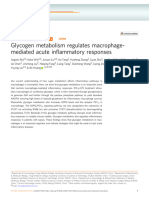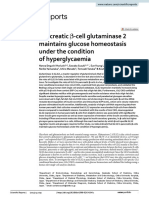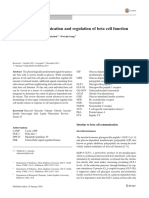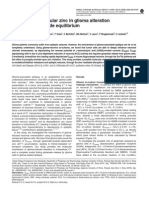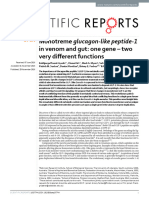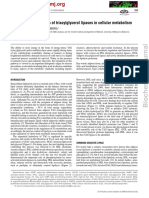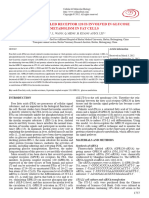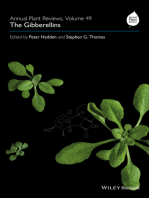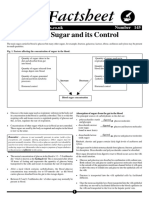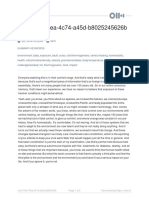Roles of two protein phosphatases, Reg1-Glc7 andSit4, and glycogen synthesis in regulation of SNF1protein kinase
Amparo Ruiz, Xinjing Xu, and Marian Carlson
1
Department of Genetics and Development and Department of Microbiology and Immunology, Columbia University, New York, NY 10032This contribution is part of the special series of Inaugural Articles by members of the National Academy of Sciences elected in 2009.Contributed by Marian Carlson, February 17, 2011 (sent for review December 10, 2010)
The SNF1 protein kinase of
Saccharomyces cerevisiae
is a memberoftheSNF1/AMP-activatedproteinkinasefamily,whichisessentialfor metabolic control, energy homeostasis, and stress responses ineukaryotes. SNF1 is activated in response to glucose limitation byphosphorylation of Thr210 on the activation loop of the catalyticsubunit Snf1. The SNF1
β
-subunit contains a glycogen-binding do-main that has been implicated in glucose inhibition of Snf1 Thr210phosphorylation.Toassesstheroleofglycogen,weexaminedSnf1phosphorylation in strains with altered glycogen metabolism. A
reg1
Δ
mutant, lacking Reg1-Glc7 protein phosphatase 1, exhibitselevated glycogen accumulation and phosphorylation of Snf1 dur-inggrowthonhighlevelsofglucose.Unexpectedly,mutationsthatabolished glycogen synthesis also restored Thr210 dephosphoryla-tion in glucose-grown
reg1
Δ
cells, indicating that elevated glyco-gen synthesis contributes to activation of SNF1 and that anotherphosphatase acts on Snf1. We present evidence that Sit4, a type2A-like protein phosphatase, contributes to dephosphorylation ofSnf1 Thr210. Finally, evidence that the effects of glycogen are notmediated by binding to the
β
-subunit raises the possibility thatelevated glycogen synthesis alters glucose metabolism and there-by reduces glucose signaling to the SNF1 pathway.
glucose regulation
|
signal transduction
|
yeast
T
he SNF1/AMP-activated protein kinase (AMPK) family isconserved from yeast to mammals and is essential for meta-bolic control and energy homeostasis (1, 2). The
Saccharomyces cerevisiae
SNF1 protein kinase is required for adaptation to glu-cose limitation and other stresses and for growth on carbonsources that are less preferred than glucose; it is named for thesucrose-nonfermenting phenotype of the
snf1
mutant (2). SNF1regulatestranscriptionofalargesetofgenes(3)andtheactivityof metabolic enzymes involved in carbohydrate storage and fatty acid metabolism (4
–
6).Members of the SNF1/AMPK family are heterotrimers com-posed of a catalytic
α
-subunit and regulatory
β
- and
γ
-subunits.The kinase is activated by phosphorylation of the conserved Thrresidue in the activation loop of the catalytic subunit. In mammals, AMP binds to the
γ
-subunit (7, 8) and inhibits the dephosphory-lation of the activation loop Thr (9). In
S. cerevisiae
, the
γ
-subunitof SNF1 has not been shown to bind nucleotide. Thr210 of theSnf1 catalytic subunit is phosphorylated in response to glucoselimitation and other stresses (10, 11) by the Snf1-activating kinasesSak1, Tos3, and Elm1 (12
–
14). Reg1-Glc7 protein phosphatase 1(PP1), comprising the regulatory subunit Reg1 (15) and the cat-alytic subunit Glc7, has been implicated in dephosphorylation of Thr210. Reg1 interacts physically with Snf1 (16, 17), and analysisof
reg1
Δ
mutants indicated that Reg1 is required for maintainingThr210 in the dephosphorylated state (10) and inhibiting SNF1catalytic activity (18) during growth on high glucose. Studiessuggested that dephosphorylation of Thr210 in response to addi-tion of glucose is regulated at the level of access of Reg1-Glc7 tothe activation loop (19).
S. cerevisiae
encodes three alternate
β
-subunits, Sip1, Sip2, andGal83, that affect interactions with substrates (20, 21) and conferspeci
c subcellular localization of SNF1 (22). The
β
-subunits of SNF1 and AMPK contain a glycogen-binding domain (GBD)(23, 24) that is a member of the carbohydrate-binding modulefamily (25). For mammalian AMPK, it has been reported that, in vitro, the binding of glycogen to the GBD inhibits the activity of AMPK and its phosphorylation by activating kinases (26). TheGBD sequence is conserved in Gal83 and Sip2, except for sub-stitution of a highly conserved aromatic residue with Leu, but isless conserved in Sip1 (23, 25). In vitro, Gal83 is able to bindglycogen, whereas Sip2 does so weakly (23). Glycogen is a majorstorage carbohydrate, and in glucose-grown cultures, glycogen issynthesized during late exponential phase dependent on SNF1activity (4, 27) and is used after cells enter stationary phase (28).Deletion of the GBD from Gal83 relieved glucose inhibition of SNF1; in cells expressing Gal83
Δ
GBD as the only
β
-subunit,Snf1 Thr210 was highly phosphorylated during exponentialgrowth on high levels of glucose (29). This phenotype most likely results from the absence of the GBD rather than loss of glycogenbinding, because glycogen is low under these growth conditions,and cells with WT Gal83 but lacking glycogen synthase showednormal regulation of SNF1 (29). However, we considered thepossibility that, under conditions when glycogen levels are high,the binding of glycogen could displace the GBD relative to theSNF1 heterotrimer, thereby relieving inhibition; according tothis view, deletion of the GBD would mimic displacement.To assess the role of glycogen in regulation of SNF1, we ex-amined strains with altered glycogen metabolism, including the
reg1
Δ
mutant, which exhibits elevated glycogen accumulation (15,30, 31). Unexpectedly, we found that abolishing glycogen synthesisin the
reg1
Δ
mutant restored dephosphorylation of Snf1 Thr210duringexponentialgrowthonhighlevelsofglucose.These
ndingsimplicate glycogen synthesis in regulation of SNF1 and indicatethat Reg1-Glc7 phosphatase is not solely responsible for dephos-phorylation of Thr210. We present evidence for a role of Sit4, atype 2A-like protein phosphatase, in the regulation of SNF1.
Results
Genetic Alterations of Glycogen Metabolism Do Not Affect Snf1Thr210 Phosphorylation.
We
rst examined the regulation of Snf1Thr210phosphorylationincellswithelevatedglycogenlevelsduringexponential growth in glucose. Mutants lacking the degradativeenzymes glycogen phosphorylase (Gph1) or glycogen debranchingenzyme (Gdb1) and cells overexpressing glycogen synthase Gsy2accumulated glycogen (Fig. 1
A
and
C
). For assays of Thr210phosphorylation, cells were grown in 2% glucose and collected by
Author contributions: A.R. and M.C. designed research; A.R. and X.X. performed research;A.R. and M.C. analyzed data; and A.R. and M.C. wrote the paper.The authors declare no con
ict of interest.
1
www.pnas.org/cgi/doi/10.1073/pnas.1102758108 PNAS Early Edition
|
1 of 6
G E N E T I C S I N A U G U R A L A R T I C L E


rapid
ltrationtopreservethephosphorylationstateofSnf1,andanaliquotwassubjectedtoglucosedepletionbyresuspensionin0.05%glucose for 10 min. Extracts were prepared, and phosphorylation was assayed by immunoblot analysis. In all cases, Thr210 wasdephosphorylated in glucose-grown cells and became phosphory-lated in response to glucose limitation (Fig. 1
B
and
D
), indicatingthat the accumulation of glycogen to the levels achieved in thesecells had no effect. Glycogen-de
cient mutants lacking the self-glucosylating initiator proteins Glg1 and Glg2, the glycogen syn-thases Gsy1 and Gsy2, or the branching enzyme Glc3 also showednormal regulation of Thr210 phosphorylation (Fig. 1
A
and
B
).
Abolishing Glycogen Synthesis Restores Dephosphorylation of Thr210in the
reg1
Δ
Mutant.
The
reg1
Δ
mutant, lacking Reg1-Glc7 PP1,exhibits constitutive phosphorylation and activation of SNF1 (10,18) and accumulates glycogen (15, 30, 31) (Fig. 2
A
). To exploreeffects of the associated glycogen accumulation on the defect inregulation of SNF1, we examined the
reg1
Δ
mutant and severalglycogen-de
cient derivatives. During exponential growth on 2%glucose, the
reg1
Δ
mutant exhibited highly elevated glycogenaccumulation (Fig. 2
A
), with levels similar to those of WT cells instationary phase (48
μ
g glycogen/10
8
cells), and phosphorylation of Thr210waselevatedrelativetotheamountofSnf1protein(Fig.2
B
).Surprisingly,
reg1
Δ
glg1
Δ
glg2
Δ
,
reg1
Δ
gsy1
Δ
gsy2
Δ
, and
reg1
Δ
glc3
Δ
mutant cells exhibited normal glucose inhibition of Snf1 Thr210phosphorylation (Fig. 2
B
), indicating that, in the absence of glyco-gen synthesis, Reg1-Glc7 is not required to maintain Snf1 Thr210inthedephosphorylatedstate. Glycogen de
ciency also suppressedother
reg1
Δ
mutant phenotypes, including slow growth on glucoseand resistance to the glucose analog 2-deoxyglucose, which inhibitsSNF1 in glucose-limited cells (32) (Fig. 2
C
). These
ndings suggestthat another phosphatase can dephosphorylate Thr210.
Reg1-Glc7 Contributes to Dephosphorylation of Activated Snf1 inResponse to Increased Glucose Availability.
The addition of glucoseto glucose-depleted cells results in the rapid dephosphorylation
Fig. 1.
Regulation of Snf1 Thr210 phosphorylation in strains with alteredglycogenmetabolism.(
A
and
B
)StrainswereWTandmutants,asindicated,inthe W303 (
Left
) or BY4741 genetic background (
Right
); similar results wereobtained for all mutants in both genetic backgrounds. (
A
) Glycogen contentwasdetermined.Valuesareaveragesofsixdeterminations(barsshowSD).(
B
)Cells were grown in SC plus 2% (H, high) glucose, and an aliquot of theculture was collected by rapid
ltration. Another aliquot was collected,resuspended in SC plus 0.05% (L, low) glucose for 10 min, and collected.Extracts were prepared, and proteins (10
μ
g) were analyzed by immuno-blotting with antiphospho-Thr-172-AMPK antibody to detect phosphoryla-tion on Thr210 of Snf1 (pT210). Lower exposure did not reveal differences inphosphorylation in low glucose. Membranes were reprobed with anti-polyhistidine antibodytodetectSnf1.(
C
and
D
)W303-1Acellscarrying vectorpCM252 or pGSY2 expressing Gsy2-3xHA from the doxycycline-inducible
tetO
7
promoter (57) were grown overnight in selective SC plus 2% glucose,dilutedinfreshmediatoanOD
600
of0.2inthepresence(+)ortheabsence(
−
)of2
μ
g/mLdoxycycline(dox),andgrownfor6h.Controlculturesweretreatedwith the drug vehicle (ethanol). Similar results were obtained with inductiontimesupto16h.(
C
)Glycogencontentwasdeterminedforinducedculturesasabove. (
D
) Aliquots were collected for analysis of phosphorylated Thr210(pT210) and Snf1. Gsy2-3xHA was detected with 12CA5 antibody.
Fig. 2.
MutationsabolishingglycogensynthesisrestoreglucoseinhibitionofSnf1 in
reg1
Δ
cells. Strains were W303 derivatives; the
reg1
allele was
reg1
Δ
::HIS3
or for studies of the effects of
glc3
,
reg1
Δ
::URA3
. (
A
) Glycogen contentwas determined as in Fig. 1
A
. (
B
) Immunoblot analysis of phosphorylatedThr210 and Snf1 as in Fig. 1
B
. Values indicate relative intensity of the bandscorresponding to phosphorylated Snf1-Thr210 and total Snf1 protein (pT210/ Snf1). (
C
) Cells were grown overnight in YEP plus 2% glucose and spottedwith serial
vefold dilutions on solid YEP containing 2% glucose (Glu), 2%sucrose (Suc), or 2% sucrose plus 200
μ
g/mL 2-deoxy-
D
-glucose (Suc+2DG).Plates were incubated at 30 °C for 2 or 3 d (Suc+2DG) and photographed.
2 of 6
|
www.pnas.org/cgi/doi/10.1073/pnas.1102758108 Ruiz et al.
and inactivation of Snf1, thereby facilitating adaptation to thisenvironmental change. To address the role of Reg1-Glc7 in thisprocess, we grew cells on 2% glucose, shifted to 0.05% glucosefor 10 min, and then restored glucose to 2% for 15 min. Re-plenishment of glucose resulted in rapid and complete de-phosphorylation of Thr210 in WT and
glc3
Δ
cells but not
reg1
Δ
cells; partial dephosphorylation occurred in
reg1
Δ
glc3
Δ
cells(Fig. 3
A
). We further examined cells growing exponentially in2% glycerol plus 3% ethanol, the use of which requires SNF1activity. Thr210 was phosphorylated in all cultures; WT and
reg1
Δ
cells contained 26 and 30
μ
g glycogen/10
8
cells, respec-tively. When cells were shifted to 2% glucose for 15 min, Thr210 was dephosphorylated in WT and
glc3
Δ
cells but remained highly phosphorylated in
reg1
Δ
cells and partially phosphorylated in
reg1
Δ
glc3
Δ
cells (Fig. 3
B
). Thus, regardless of the cell
’
s capa-bility for glycogen synthesis, Reg1-Glc7 clearly contributed to therapid dephosphorylation of Snf1 in response to increased glucoseavailability. However, in
reg1
Δ
glc3
Δ
cells, it was apparent thatanother phosphatase also contributes.
Sit4 Phosphatase Has a Role in Dephosphorylation of Thr210.
Wenextassessed the involvement of other protein phosphatases inmaintaining Snf1 Thr210 in the dephosphorylated state duringgrowth in glucose. PP2A and PP2C
α
dephosphorylate the corre-sponding Thr of mammalian AMPK in vitro (9, 33
–
35), Ppm1Eand PP1-R6 have been implicated in mammalian cells (36, 37),and mammalian PP2A inactivates SNF1 in vitro (6). The PP2Cfamily in
S. cerevisiae
includes seven members (Ptc1 to Ptc7); Ptc1is the most closely related to Ppm1E. The seven single
ptc
Δ
mutants and the triple
ptc1
Δ
ptc2
Δ
ptc3
Δ
mutant (38) showednormal regulation of Thr210 phosphorylation during growth inglucose and in response to glucose depletion. PP2A comprisesacatalyticsubunit(Pph21orPph22),aregulatorysubunit(Rts1orCdc55), and a scaffold subunit (Tpd3); we found no defect in
pph21
Δ
pph22
Δ
,
rts1
Δ
cdc55
Δ
, or
tpd3
Δ
mutants.We then examined mutants of the BY4741 background car-rying deletions of additional genes encoding nonessential cata-lytic or regulatory subunits of protein phosphatases:
bni4
,
bud14
,
n1
,
gac1
,
gip1
,
gip2
,
glc8
,
mhp1
,
pig1
,
pig2
,
red1
,
ref2
,
reg2
,
shp1
,
sla1
,
ppz1
,
ppz2
,
sal6
,
pph3
,
psy2
,
psy4
,
ppg1
,
sit4
,
sap4
,
sap155
,
sap185
,
sap190
,
cnb1
,
ppt1
,
ptp1
,
ptp2
,
ptp3
,
mih1
,
ltp1
,
siw14
,
tep1
,
ymr1
,
dbf2
,
pps1
,
yvh1
,
msg5
, and
sdp1
. The
sit4
Δ
mutant was the only one of this set that showed elevated Thr210 phos-phorylation during growth on 2% glucose (Fig. 4
A
).Sit4 is a PP2A-like phosphatase that functions in the mitoticG1/S transition (39) and is involved in the target of rapamycin(TOR) pathway (40). Further analysis of the
sit4
Δ
mutant showedthat phosphorylation of Thr210 increased on glucose depletion,and subsequent glucose replenishment resulted in partial de-phosphorylation (Fig. 4
A
). Sit4 associates with four noncatalyticsubunits that are nonessential, Sap4, Sap155, Sap185, and Sap190(41), and the cognate quadruple deletion mutant exhibited a de-fect in dephosphorylation of Thr210 similar to that of the
sit4
Δ
mutant. Sit4 is involved in the control of glycogen metabolism(42, 43), and
sit4
Δ
cells accumulated modest levels of glycogenduring exponential growth in glucose (Fig. 4
B
). Analysis of
sit4
Δ
glc3
Δ
cells showed that the absence of glycogen synthesis restoreddephosphorylation of Thr210 in glucose-grown cells but did notabrogate the defect observed on glucose replenishment (Fig. 4
A
), which was also the case for
reg1
Δ
glc3
Δ
cells. These
ndings in-dicate that Sit4, like Reg1-Glc7, contributes to the rapid de-phosphorylation of Thr210 in response to increased glucoseavailability, and they raise the possibility that Reg1-Glc7 andSit4 are together responsible for dephosphorylating Thr210 in
Fig. 3.
Reg1 is required for Snf1 dephosphorylation in response to glucosereplenishment. Strains were as in Fig. 2. (
A
) Immunoblot analysis was as inFig. 1
B
except that, after cells were resuspended in SC plus 0.05% glucose for10 min, an aliquot was incubated in SC plus 2% glucose (+G) for 15 min andcollected. Values indicate relative intensity of the bands corresponding tophosphorylated Snf1-Thr210 and total Snf1 protein (pT210/Snf1). (
B
) Cellswere grown to midlog phase in SC plus 2% glycerol and 3% ethanol (GE); analiquot was shifted to SC plus 2% glucose for 15 min (G). Cells were collectedand analyzed as above.
Fig. 4.
Effects of
sit4
Δ
on Snf1 regulation. Strains carried the indicatedmutations introduced into strain CY4029 (W303-1A
SSD1-v1
); the
SSD1-v1
allele is essential for viability of W303
sit4
Δ
mutants (41). (
A
) Cells werecollected and analyzed as in Fig. 3
A
. (
B
) Glycogen content was determined asabove. Similar results were obtained with the BY4741
sit4
Δ
mutant. (
C
) Sit4-TAP was expressed from the genomic locus of
snf1
Δ
SIT4-TAP
cells, and Snf1-3xHA was expressed from the native promoter on centromeric plasmidpYL225 or multicopy (2
μ
) plasmid pYL230, derivatives of vectors pRS316 (58)and pRS426 (59), respectively. Cells carrying pRS426 (V) served as control.Cells were grown to midlog phase in SC plus 2% glucose (H), and an aliquotwas shifted to 0.05% glucose for 10 (L10) or 30 min (L30). Extracts wereprepared, Sit4-TAP was isolated, and copurifying proteins were analyzed byimmunoblotting, as described in
Materials and Methods
. TAP-puri
ed pro-teins were recovered from 200
μ
g cell extract. Input was 5
μ
g cell extract.
Ruiz et al. PNAS Early Edition
|
3 of 6
G E N E T I C S I N A U G U R A L A R T I C L E
glucose-growncells.The
reg1
Δ
sit4
Δ
and
reg1
Δ
sit4
Δ
glc3
Δ
mutantsare inviable.Previous studies detected physical interaction of Reg1 with Snf1(16, 17). To assess the association of Sit4 with Snf1, we expressedHA-tagged Snf1 from its native promoter on a centromeric ormulticopy plasmid in a
snf1
Δ
strain expressing tandem af
nity puri
cation (TAP)-tagged (44) Sit4 from the genomic
SIT4-TAP
locus. Extracts were prepared from cultures grown under differentconditions, and Sit4-TAP was puri
ed. The copurifying proteins were resolved by SDS/PAGE and analyzed by immunoblotting.Copuri
cation of Snf1-HA with Sit4-TAP was barely detectable when Snf1-HA was expressed from the centromeric plasmid, but it was clearly evident when Snf1-HA was expressed at higher levels(Fig. 4
C
). This evidence for physical association is consistent withthe idea that Sit4 directly dephosphorylates Thr210.
reg1
Δ
Affects Regulation of SNF1 Containing Different GBDs.
Havinginitiated this work because deletion of the GBD from Gal83relieves glucose inhibition of SNF1, we returned to the possibility that, in
reg1
Δ
cells, the binding of glycogen displaces the GBDrelative to the SNF1 heterotrimer, thereby affecting Thr210phosphorylation. The GBD of Gal83, the major
β
-subunit inglucose-grown cells (22, 45), bound glycogen in vitro, whereas theSip2 GBD bound glycogen much less strongly, and the GBD isnot well-conserved in Sip1 (23).To assess therole ofthe GBD, weexamined the effects of
reg1
Δ
in cells expressing only Sip1 andSip2 (
gal83
Δ
) or only Sip1 (
gal83
Δ
sip2
Δ
). In both cases,
reg1
Δ
causedphosphorylationofThr210inglucose-growncells(Fig.5
A
,compare lanes 1 and 2 and lanes 5 and 6), and introduction of
gsy1
Δ
gsy2
Δ
restored dephosphorylation (Fig. 5
A
, lanes 4 and 8).The
reg1
Δ
and
gsy1
Δ
gsy2
Δ
mutationsalsoaffected2-deoxyglucoseresistance, as in Fig. 2
C
, regardless of the
β
-subunit present.We also examined the effect of
reg1
Δ
in cells expressingGal83W184A in which Ala is substituted for Trp184, which ishighly conserved in carbohydrate-binding modules (25). Sub-stitution of the analogous residue of the GBD of mammalian AMPK, Trp100, abolished binding to glycogen, and the crystalstructure of AMPK GBD with bound
β
-cyclodextrin identi
edTrp100 as a key residue (24, 46). Previous studies showed thatthe GBD of Gal83W184A,R214Q did not bind glycogen in vitro(23). In glucose-grown
reg1
Δ
gal83
Δ
sip1
Δ
sip2
Δ
(
reg1
Δ βΔ
) cells,Thr210 phosphorylation was elevated to the same extent in cellsexpressing WT Gal83 or Gal83W184A (Fig. 5
B
). Together, these
ndings suggest that the effect of
reg1
Δ
on Thr210 phosphory-lation does not depend on glycogen binding to the GBD.
Discussion
PreviousevidencethattheGBDofthe
β
-subunitGal83isrequiredfor glucose inhibition of SNF1 led us to assess the role of glycogeninregulationofSNF1. Analysisofthe
reg1
Δ
mutant,which exhibitsboth elevated glycogen accumulation and elevated Snf1 Thr210phosphorylation during growth on high levels of glucose, gave anunexpected result. Mutations that abolished glycogen synthesisrestored dephosphorylation of Snf1 Thr210, indicating that ele- vated glycogen synthesis has a role in the phosphorylation of Snf1in glucose-grown
reg1
Δ
cells and that Reg1-Glc7 PP1 cannot besolely responsible for dephosphorylation of Snf1.We present evidence that the PP2A-related phosphatase Sit4also contributes to the dephosphorylation of Snf1. The
sit4
Δ
mutant similarly exhibited Thr210 phosphorylation and elevatedglycogen accumulation during growth on high glucose, and abol-ishing glycogen synthesis similarly restored dephosphorylation. Inglucose-depleted
sit4
Δ
cells, the rapid dephosphorylation of ac-tivated Snf1 in response to glucose replenishment was impaired.We also show that Sit4, like Reg1, is physically associated withSnf1, consistent with a direct role in dephosphorylation. The
sit4
Δ
reg1
Δ
and
sit4
Δ
reg1
Δ
glc3
Δ
mutants are inviable, but we havefound that introduction of
snf1
Δ
restores viability. The simplemodel is that Reg1-Glc7 and Sit4 are together responsible fordephosphorylation of Thr210 (Fig. 6).It is possible that other phosphatases contribute to regulationof SNF1, perhaps under different growth conditions. Analysis of mutants lacking nonessential catalytic and regulatory subunits didnot identify another phosphatase that plays a role in the inhibitionof SNF1 during growth on high levels of glucose; however, such anactivity could be encoded by multiple genes with overlapping func-
Fig. 5.
Regulation of Snf1 Thr210 phosphorylation in the presence of dif-ferent
β
-subunits. Cells were grown in SC plus 2% glucose (H) or shifted to0.05% glucose (L) and collected for immunoblot analysis of phosphorylatedThr210 and Snf1. (
A
) Strains were derivatives of W303 carrying
REG1
(WT) or
reg1
Δ
(
Δ
). (
B
) Gal83 (WT) and its derivative Gal83W184A were expressed asfusions to GFP from the native promoter on a centromeric plasmid (22) in
gal83
Δ
sip1
Δ
sip2
Δ
(
βΔ
)
or
reg1
Δ
gal83
Δ
sip1
Δ
sip2
Δ
(
reg1
Δ β
Δ
) cells. All lanesare from the same blot.
Fig. 6.
Model for the roles of Reg1-Glc7 and Sit4 in regulation of Snf1 phos-phorylation during growth on high glucose. Reg1-Glc7 and Sit4 indepen-dently dephosphorylate Snf1 (arrows). The high glucose signal promotesdephosphorylation (arrow), possibly by promoting access of phosphatases toSnf1 Thr210 or by direct regulation of phosphatases. Reg1-Glc7 and Sit4 alsoinhibit (bars) glycogen synthesis; other mechanisms controlling glycogen syn-thesis are not shown. Elevated glycogen synthesis during growth on highglucose inhibits dephosphorylation of Snf1 Thr210; dashed lines indicatethat possible mechanisms include direct inhibition of dephosphorylation anddown-regulation of the glucose signal. In the absence of one of the phospha-tases, increased glycogen synthesis inhibits dephosphorylation by the remain-ing phosphatase. If glycogen synthesis is abolished, the function of theremaining phosphatase is suf
cient for dephosphorylation of Thr210.
4 of 6
|
www.pnas.org/cgi/doi/10.1073/pnas.1102758108 Ruiz et al.







